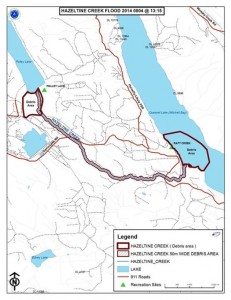A little over a month ago, a dam failed in a tailings pond at the Mount Polley mine near Likely, British Columbia. We’ve written about the breach on a couple occasions, but we haven’t written about it lately.
At the end of August, the Ministry of Environment said that elevated concentrations of copper, iron, manganese, arsenic, silver, selenium and vanadium that exceed provincial standards were found during testing near the Mount Polley mine. The Ministry also claimed that there were elevated concentrations of those metals in that area before the spill, and as long as the water wasn’t cloudy, it was supposedly safe to drink.
However, this isn’t reassuring to the people who live in the area. “We’re drinking bottled water because on the 18th, the first test done after Mount Polley, the water was really clear and on the 20th the plume was already here,” said Pohney Whitmer, who lives on Quesnel Lake. On the other hand, Steve Robertson, Imperial Metals’ vice-chairman of corporate affairs, claims that he’s been drinking it while living in Likely.
Then, there’s the strange blue film on Quesnel Lake. Marine biologist Alexandra Morton went to the site to test the water, and local residents told her about the blue film. She said that; “There’s a number of residents in the area who were concerned about it because they had touched it and it caused a drying sensation on their arms and it burned their fingers. In transferring it from my net to my jars, I got it on my fingers — and it does burn.
“It feels like a jellyfish sting. It looks like oil, but it breaks up. It kind of acts like hot wax put on water; it forms this stiff film.”
To top it off, on Thursday, Imperial Metals said that nearly 25 million cubic meters of contaminated water and mine waste spilled into surrounding waterways, or about 78 per cent more than the first estimates. This includes 10.6 million cubic meters (2.8 billion gallons) of water, 7.3 million cubic meters (1.9 billion gallons) of tailings and 6.5 million cubic meters (1.7 billion gallons) of interstitial water, which is the water that sits between the crushed rock in the tailings pond.
As seems to be par for the course with recent environmental disasters, the original estimates of the spillage don’t match up with reality at all. And, like the others, we have no idea of what’s actually happening right now; not to mention the long term impacts. Summer is the dry season, and the fall rains and spring melt will almost assuredly raise the concentrations due to runoff and stirring of the sediment on the lake and river bottoms. The daily discharge from the Quesnel River, which flows from Quesnel Lake, more than triples during the spring melt. causing a “tremendous turbulent flushing effect,” says Vancouver Sun columnist Stephen Hume.
The cost to clean up the mess is unknown at the present time, but we’re pretty sure of two things; it will be a long and expensive job, and the taxpayers of British Columbia will be stuck with most of the costs. Isn’t it time we start holding these people responsible for their actions? And, isn’t it about time that we elect people who aren’t in bed with oil and mining companies? It’s up to us; they aren’t going to change unless we make them change.


